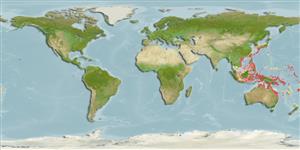Common names from other countries
Environment: milieu / climate zone / depth range / distribution range
Οικολογία
; εύρος βάθους 0 - 20 m (Ref. 75835). Tropical
Western Pacific: Japan, China, Hong Kong, Guam and Indonesia.
Length at first maturity / Μέγεθος / Βάρος / Age
Maturity: Lm ? range ? - ? cm
Found in intertidal to 20 m, on coarse sand and stones (Ref. 75835).
Life cycle and mating behavior
Γεννητική Ωρίμανση | Αναπαραγωγή | Γεννοβολία | Αβγά | Γονιμότητα | Προνύμφες
Members of the order Patellogastropoda are mostly gonochoric and broadcast spawners. Life cycle: Embryos develop into planktonic trocophore larvae and later into juvenile veligers before becoming fully grown adults.
Smith, B.D. 2003. (Ref. 3116)
IUCN Red List Status (Ref. 130435)
CITES status (Ref. 108899)
Not Evaluated
Not Evaluated
Threat to humans
Harmless
Human uses
| FishSource |
Εργαλεία
Περισσότερες πληροφορίες
Age/Size
Αύξηση
Length-weight
Length-length
Μορφολογία
Προνύμφες
Αφθονία
Διαδικτυακές πηγές
Estimates based on models
Preferred temperature
(Ref.
115969): 23.6 - 29.3, mean 28.4 (based on 1691 cells).
Price category
Unknown.
